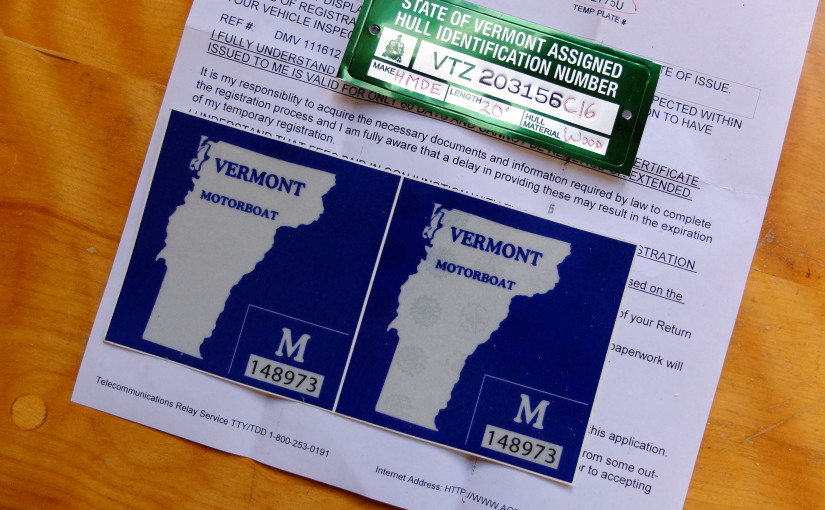I did not give much thought to registering my new boat while I was building it, but I was aware that it could be a process because a friend of mine had built a boat from trees he felled and sawed out only to find that he had to pay sales tax when he went to register the boat, and he had to get a Hull ID number from the Coast Guard, which took him 4 months. I went so far during the building phase as to burn a ‘serial number’ on the inside of the stem, naively thinking that would be sufficient for the box on the form labeled ‘VIN’. I called mine ‘#01’. Sort of a joke on them, bureaucracy. Turns out, they don’t have much of a sense of humor. Different states have different rules, and I played with the idea of registering it in Maine (I live in Vermont) because that is where I will use it, mostly, but also because it looked a little cheaper and I wanted the cachet of a Maine number on my boat, since that is its heritage. The kicker is in the Hull ID Number.
Briefly, every recreational motorboat needs a Hull ID Number (also called Vehicle ID Number: VIN) to be registered. You also need to pay some kind of sales tax, as if you had bought the boat; you need a registration and boat numbers, and you may need to apply for a certificate of origin and/or title. The application forms for the Hull ID Number state that an inspector from the DMV or applicable organization will come to your location and personally apply the ID plate, this to prevent fraud I guess. In fact, when I went to try my luck today at the local Vermont DMV branch, the agent gave me the Hull tag to apply myself. I don’t know if they would have done that through the mail, and I don’t know how Maine would have handled it. Now that I have a hull ID number, it should be no problem to register the boat in Maine when I decide to keep it there.
The ‘sales tax’ is a little odd in that I either already had paid sales tax for the materials used, or made a general ‘use tax’ payment at income tax time which is designed to collect the tax due on out-of-state / internet purchases. The Vermont form ‘Application for VIN’ says that the form will be rejected if a bill of sale is not included for ‘any and all parts’ used in the assembly. Based on the fact that I had no such bills of sale, I was not in a position to argue with the DMV clerk. I lieu of bills of sale, I made up a semi-complete materials list – so many board feet of white cedar, 3 pounds of tacks, etc. – and included copies of either canceled checks or credit card statements. Some materials I had not bought yet, like the epoxy and fiberglass cloth, but put together a shopping cart of my intended purchases and included a print-screen of that. This list was accepted, and the sum total was used as the taxable price. The DMV subtracted from the tax due any tax I could prove I had paid, like on the motor, and this is the advantage of actually keeping receipts, if you want to trouble yourself to that extent.
I ended up preparing 4 forms, plus my materials list. The 4 forms were the VIN Assignment form, a Manufacturers Statement of Origin form, a Use Tax form, and a Motorboat Registration form. It was a little like playing poker with the DMV agent – he held all the high cards and he didn’t divulge a lot of his thinking. I paid $160.54 which breaks down to $43 for a 1-year registration, $97.54 tax on my materials, plus $20 for something that he didn’t tell me, but I hope is a title – that’s what a title costs, although one form says canoes over 16 feet with motors less than 10 HP don’t need a title. I will wait and see – just like Christmas.
I didn’t like the ‘Make’ and ‘Model’ names he chose – my Make is “HMDE” and Model “MBT” – my choice for Make was “GLT” for Grand Laker Type, and Model was simply “Grand”, but you can’t have everything.
